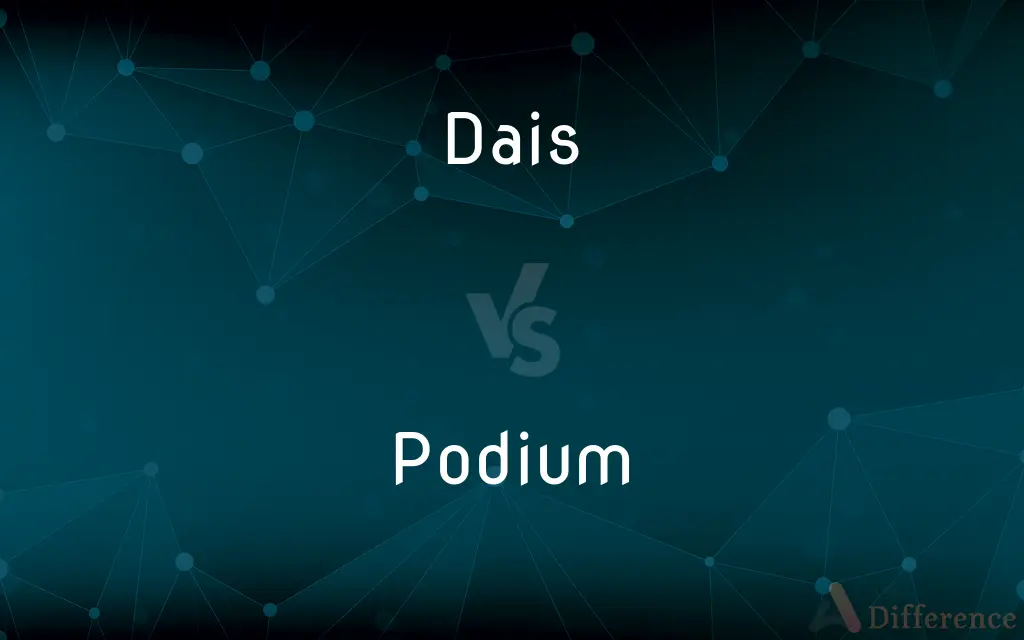Dais vs. Podium — What's the Difference?
By Urooj Arif & Fiza Rafique — Updated on March 6, 2024
A dais is a raised platform for speakers or honored guests, while a podium is a stand for holding notes or supporting speakers during a presentation.

Difference Between Dais and Podium
Table of Contents
ADVERTISEMENT
Key Differences
The term "dais" refers to a raised platform that is often used in formal or ceremonial contexts. It is typically large enough to accommodate a group of people, such as speakers, honored guests, or a head table at a banquet. On the other hand, a "podium" is generally a smaller stand or platform designed to elevate a single person for visibility or to support lecture materials, such as notes or a laptop, during a presentation or speech.
While a dais is primarily focused on elevating individuals for prominence or ceremonial purposes, a podium is used more for functional support during speeches, lectures, or performances. This functional difference highlights the dais's role in emphasizing the importance or status of individuals, whereas the podium serves as a practical aid for speakers.
In terms of size and design, dais platforms are often expansive, accommodating multiple people and sometimes featuring elaborate decorations to suit formal occasions. Podiums, in contrast, are designed for individual use, with a focus on practicality and convenience, often equipped with features like adjustable height or built-in sound systems.
Cultural and contextual usage also differentiates these terms. A dais is commonly associated with grandeur and formality, used in settings like governmental, academic, or corporate events to denote distinction. Podiums, however, are ubiquitous across various contexts, from educational classrooms to sports events, emphasizing their versatility and functionality.
Despite these differences, both a dais and a podium serve to elevate and distinguish individuals within a gathering, whether through physical elevation or by providing a platform for speech and presentation. This shared purpose underlines their roles in facilitating communication and honoring individuals or achievements in diverse settings.
ADVERTISEMENT
Comparison Chart
Primary Use
Elevating individuals for prominence
Supporting speakers and materials
Size
Large, often accommodating multiple people
Smaller, typically for individual use
Context
Formal ceremonies and events
Various, including speeches and lectures
Design
May include elaborate decorations
Focused on practicality, sometimes with built-in features
Cultural Association
Grandeur and formality
Versatility and functionality
Compare with Definitions
Dais
A raised platform for speakers or honored guests at an event.
The bride and groom sat on the dais at the wedding reception.
Podium
Designed to support lecture materials or notes.
The professor placed his notes on the podium during the lecture.
Dais
Used in formal or ceremonial contexts.
The university president delivered her address from the dais.
Podium
Enhances visibility and audibility of speakers.
The athlete gave her victory speech from the podium.
Dais
Signifies importance or status.
Award recipients were invited onto the dais for recognition.
Podium
Commonly used in educational and professional settings.
Winners received their medals standing on the podium.
Dais
Can accommodate a group of people.
The panel discussion took place on a large dais.
Podium
A stand or platform for a speaker or performer.
The keynote speaker approached the podium.
Dais
Often features elaborate decorations.
The dais was adorned with flowers and fine linens for the gala.
Podium
Can feature built-in sound systems or adjustable heights.
The podium was equipped with a microphone for the presentation.
Dais
A dais or daïs ( or , American English also but sometimes considered nonstandard) is a raised platform at the front of a room or hall, usually for one or more speakers or honored guests.Historically, the dais was a part of the floor at the end of a medieval hall, raised a step above the rest of the room. On this, the master of the household or assembly (e.g.
Podium
A podium (plural podiums or podia) is a platform used to raise something to a short distance above its surroundings. It derives from the Greek πόδι (foot).
Dais
A raised platform, as in a lecture hall, for speakers or honored guests.
Podium
An elevated platform, as for an orchestra conductor or public speaker.
Dais
A raised platform in a room for a high table, a seat of honour, a throne, or other dignified occupancy, such as ancestral statues; a similar platform supporting a lectern, pulpit, etc., which may be used to speak from.
Podium
A stand for holding the notes of a public speaker; a lectern.
Dais
A platform slightly raised above the floor of a hall or large room, giving distinction to the table and seats placed upon it for the chief guests.
Podium
The dwarf wall surrounding the arena of an amphitheatre, from the top of which the seats began.
Dais
A platform raised above the surrounding level to give prominence to the person on it
Podium
A platform raised above the surrounding level to give prominence to the person on it
Common Curiosities
What are the typical features of a podium?
Podiums are designed for practicality, sometimes including features like adjustable height or built-in sound systems.
Where might you find a dais used?
A dais is often used in formal events, such as weddings, banquets, or ceremonial gatherings.
What is a dais?
A dais is a raised platform used primarily in formal or ceremonial settings to elevate individuals for prominence.
What is a podium?
A podium is a stand or small platform used to elevate a speaker for visibility or to support speaking materials during presentations.
What practical considerations might influence the choice between a dais and a podium?
Considerations include the number of people being highlighted, the formality of the event, and the specific functional needs of the speakers.
Can a dais and a podium be used interchangeably?
While both serve to elevate individuals, they differ in size, context, and function, making them not typically interchangeable.
Can the design of a podium enhance a presentation?
Yes, features like adjustable heights and built-in sound systems can significantly enhance a speaker's effectiveness and audience engagement.
How does the size of a dais compare to a podium?
A dais is generally larger, designed to accommodate multiple people, while a podium is smaller, usually for individual use.
Is a podium only used for speeches?
While commonly used for speeches, podiums can also support performers or serve as winners' platforms in sports.
How do cultural contexts affect the use of daises and podiums?
Cultural and contextual differences dictate their use, with daises often reserved for more formal or ceremonial occasions and podiums used in a wider range of settings for functionality.
Can a dais have built-in features like a podium?
Daises are more focused on size and decoration, but they may include features for amplification or presentation as needed.
How does the design of a dais reflect its purpose?
The design often includes elements of grandeur and space to accommodate and elevate multiple distinguished individuals.
How do daises and podiums contribute to the atmosphere of an event?
Daises add a sense of formality and distinction, while podiums facilitate communication and interaction, each contributing uniquely to the event's atmosphere.
Why would an event choose to use a dais over a podium?
An event might choose a dais to emphasize the importance or status of the individuals, aligning with the event's formality and grandeur.
Is it common for public speaking events to have both a dais and a podium?
It's possible, especially in large or formal events where a dais might accommodate honored guests and a podium used for speeches.
Share Your Discovery

Previous Comparison
Entrust vs. Trust
Next Comparison
Timberland vs. WoodlandAuthor Spotlight
Written by
Urooj ArifUrooj is a skilled content writer at Ask Difference, known for her exceptional ability to simplify complex topics into engaging and informative content. With a passion for research and a flair for clear, concise writing, she consistently delivers articles that resonate with our diverse audience.
Co-written by
Fiza RafiqueFiza Rafique is a skilled content writer at AskDifference.com, where she meticulously refines and enhances written pieces. Drawing from her vast editorial expertise, Fiza ensures clarity, accuracy, and precision in every article. Passionate about language, she continually seeks to elevate the quality of content for readers worldwide.














































